Charting
NDisc from Sony to Philips to SuperFX to NEC
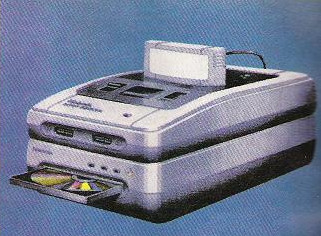 Even
though this site is supposed to be a 1990s style tribute to StarFox,
we need to get some SNES CD-ROM history sorted out. It’s too
easy to get confused with the stupid Sony debacle, the Philips
drive, the SuperFX, and the “32-bit”ness.
Even
though this site is supposed to be a 1990s style tribute to StarFox,
we need to get some SNES CD-ROM history sorted out. It’s too
easy to get confused with the stupid Sony debacle, the Philips
drive, the SuperFX, and the “32-bit”ness.
In
facial media youtube-r speak, let’s “EXPLAIN” this
“SHOCKING” and “INSANE” history!
The main objectives of this page are to:
Explain the
differences between 3 known Super NES CD-ROM accessories. And a
rumored fourth!
Explain why
Nintendo dumping Sony was NOT a mistake, and should have
happened earlier.
Give context why this was
important. The snazzy new CD-ROM hardware could have been a step
backward from cartridges.
There's actually a fantastic
Kotaku article that documents this saga very well except for a
couple of missing elements. And another on
nsider.
Back in the 1990s there were no news
websites to scour for this information. You had to dig hard between
the magazines, writing to Nintendo directly, hunting through patents,
and business news electronic periodical searches .
If one pieces together SNES CD-ROM
information in sequence, one gets a rare treat in this
industry -- outsiders able to witness the labored development of a
product as it changes to meet evolving needs of the marketplace.
Products evolve
and change frequently before coming to market, and not always in the
correct direction. For example, in recent years (circa 2019) Jez San
(of Argonaut fame) spoke of his efforts to
build a full-color VR system that was canned in favor of Virtual
Boy.
Obligatory Background
So what led up to
the CD-ROM era?
In 1982 Sony and Philips introduced the
"Compact Disc", so termed because it was much smaller than
laserdisc. Although it was envisioned as a general data storage
medium from day one, throughout the 1980s "CD" was more
synonymous with the Red Book audio format (audio CDs) largely due to
the format's cost.
As the
1990s approached the feasibility of marrying optical media and games
seemed imminent. The PC gaming crowd even invented a new marketing
buzzword, "multimedia"! It was a generic word
vaguely meaning "a combination of video, pictures, voice...."
but really just meaning "we now have a bulk storage device and
now we can make video games, too".
Growing Pains: Multimedia or Muddled Media?
Reality was another story. What value
did these expensive add-ons even provide?
1. Cost, although coming down, was still a
huge factor.
The 1991
Sears WishBook catalog, page 506, listed the original
TurboGrafx-16 CD-ROM2 attachment (a barebones drive with no games
and still requires the TurboGrafx-16 to attach it to) for $299.99.
Sega CD
(again, an accessory that requires investment in a Sega Genesis)
also cost US$300 when it was first introduced.
Nintendo promised a $200 CD-ROM
accessory with superior capability. The Electronic Gaming Monthly
editorial rabble always laughed and lambasted this as impossible. “A
32-Bit system wih Philips CD-I compatibility for $200 by the Winter
of 1993-1994? Come on Nintendo! How in the world are you going to do
that?” (Electronic Gaming Monthly, March 1993, Volume
6, Issue 3, page 16). They were unaware the declining cost of these
components. That low-power 32-bit chip was already on the market In
1991. Regardless, even a $200 accessory is still twice the cost of a
bare-bones Super NES ($99.99) in 1993.
2. When you suddenly have bulk capacity, at
costs multiplying that of the original console, what do you do
with it?
You can copy
lots of small games into the space. This is called "shovelware",
which no one wants to spend hundreds of dollars on a dedicated unit
for.
You can have
a normal size game and tack on some Red Book CD audio tracks. In
other words, enhanced audio, but no improvement elsewhere. In fact,
depending on the amount of RAM you have, this can actually downgrade
the rest of the game versus a huge ROM cartridge.
You can fill
the space with video, except:
You can't
fit enormous amounts of video even with compression. (Even
VCD format Hollywood movie fills 2 discs!)
You only
have 150KBytes/second you can pull from the disc, for both audio
and video. About 1 megabit/second.
You don't
have enough horsepower to run expensive MPEG1 algorithms on video.
(Even the Philips CD-I and 3DO consoles required expensive MPEG
hardware add-ons to support MPEG video. Again, talk about a
segmented market when you need an add-on for an already obscure
console.) Most video compression involved some form of lightweight
"cinepak" style routines and try to fit inside some small
window, often cutting as many frames as possible and as many colors
as possible to fit in the confines of the console in question.
Video
production is expensive. How does it benefit your gameplay?
Or you can spend lots of money making
an even bigger game, breaking it up into small chunks you can load
into RAM. This means your customers have to own the base console, an
expensive CD attachment, and still be willing to foot the bill for
an expensive CD-ROM game. Who cares if the manufacturing cost of the
disc is small if you still have many millions of dollars in
development cost to recoup? And again, now you have a smaller
audience of CD-ROM customers to divide that cost between.
3. What good is a huge bulk storage device
that you can only sip data through a straw? To be useful, suddenly
you need more RAM. And if you can afford enough RAM, by then you can
also afford a bigger cartridge! So then you're chasing your tail
again. Is your CD-ROM really an upgrade over the cartridge?
Your game
console can only manipulate so much data per frame. There's a limit
to how big your game level database will be and how many such levels
you can afford to produce.
Cartridge
ROM grows exponentially with time, doubling every 18 months with
Moore's Law. But once the CD-ROM and its RAM are finalized they are
set in stone and do not grow at all unless you left room for a RAM
upgrade.
If your new
cartridge is sufficiently bigger than your old CD-ROM RAM,
eventually you get to a point where the cartridge game can throw
more data per level than you can fit in RAM!
We've seen
this many times!
One example
was Street Fighter 2 on the TurboGrafx-16/PC-Engine.
The game and its 12 combatants took 20 megabits of cartridge space.
To load up 2 such combatants from CD-ROM would take more RAM than
the CD system had!
Electronic
Gaming Monthly (April 1993, volume 6, issue 4, page 50) ran an
article on this conundrum. Capcom considered releasing the
game as a cartridge + CD-ROM combination, where the game ran on
cartridge and streamed background music off CD. Obviously
this never happened.
This
scenario led to the TurboDuo "Arcade Card", which was a
RAM size upgrade. Unsurprisingly it was useful for porting other
such one-on-one tournament fighting games like SNK’s Art
of Fighting.
In later
years we saw it again with Mortal Kombat 3 on the Sony
Playstation. Shang Tsung's ability to morph into other
combatants required the game to pause just to load that new set of
combatant data into RAM.
The Neo-Geo
CD in 1994 had more RAM than the N64 had in 1996. Its entire
purpose was to load a usable amount of CD-ROM game data into a
virtual cartridge. It was ample enough to hold the early generation
Neo-Geo cartridge games (Magician Lord, Mutation Nation,
Last Resort, etc.) entirely in RAM (except for redbook
streamed audio remixes). But by this point all new large tournament
fighting games were hundreds of megabits.
Was it
really worth spending several hundred dollars for a CD-only system
just to play older games well? Those same older games that by this
point would cost much less to re-manufacture as new cartridges
with fewer/denser ROM chips in the first place!
And meanwhile now all of your new
games need to be developed with a full cartridge in mind (for MVS
arcade and AES system owners) and still be somehow able to fit
enough useful chunks into the RAM of the CD system?
Congratulations --- you just made game development harder, not
easier.
Nintendo Power volume 35 seemed as
eager as everyone. "How would you like to go one-on-one with
Michael Jordan?" they wrote on page 71. But it wasn't long
before Nintendo soured on what they saw. 9 months later, in volume
44, on Super Power Club extra, page 15, they spend paragraphs talking
about the need to improve the gaming experience over "cartridge
games on a disc".
Unbeknownst to most readers the SNES CD
effort had gone through at least 3 major product revisions by that
point! It was a major effort not only full of corporate politics
(that story is beaten to death now) but also to make a product stand
out not only against the competition but also against its cartridge
bretheren.
CONCLUSION:
An expensive CD-ROM accessory would have to be sufficiently capable
to justify its own existence for the duration of the console's
lifetime.
The Sources
Contemporaneous Periodicals
In the early 1990s most sources were in
printed magazines that ranged from "highly accurate" to
"highly speculative" to "highly opinionated".
Worse, they gathered juicy bits of news from their own undocumented
sources (frequently Japanese magazine correspondents) and presented
it as their own article. And while these articles were often accurate
(e.g. Electronic Gaming Monthly's final block diagram (March
1993, Volume 6, Issue 3, page 52) matches the 1995 patent), they'd be
juxtaposed in the same issue with articles by Quarterman that
read like a foreign language rumor mill. Not unlike the Internet
of today! Some things never change.
Physical Devices
One of the greatest sources in recent years
was the discovery and teardown of the prototype Sony unit.
Patents
Electronic patent searches by website were a
novel thing by the mid 1990s, long after the CD unit was shelved. And
while patents can be controversial (or sometimes intentionally vague)
in their own right, generally a patent on a physical product requires
some sort of physical product or implementation before it can be
granted.
The patents for the Super FX (#5,357,604) and the final CD-ROM
add-on are both public.
Developer Documentation
In recent years Nintendo's CD-ROM developer
documentation was discovered. It confirmed the EGM block diagram and
details the XA format and its ADPCM compression. The most juicy
details (how to control the data flow from CD-ROM to HANDS) are still
missing.
Financial Analyst Reports, courtesy of
InfoTrac
There is a supreme irony that while the
video game industry struggled with CD-ROM, libraries around the
country used them very effectively as a text-only data archive called
InfoTrac. One of
the greatest sources on the Super NES CD-ROM product was itself
archived on this CD-ROM system. Think of InfoTrac as a self-contained
world-wide-web and search engine all in one, except the searches were
periodicals listings. Most of the search results were abstract
summaries of the text (occasionally whole articles). By academic
standards that technically means relying on InfoTrac
without finding the original article is a dreaded Secondary
Source, but it's about as close to
authoritative as you can get these days.
The other irony is that our big source here
is from Lehman Brothers, a once large company that imploded
spectacularly in the 2008 financial meltdown. So good luck finding
the original sources.
A financial analyst named K. Segawa
authored a Nintendo company report on Feb 24, 1993 and it was
captured in the InfoTrac General BusinessFile October 1990 -
October 1993. This one details the 32-bit upgrade.
The same author
wrote an earlier company report on September 14, 1992 with a
paragraph mentioning launch dates for the previous (pre-32-bit) unit.
I have scans of
these InfoTrac summaries here. Click for larger sizes.
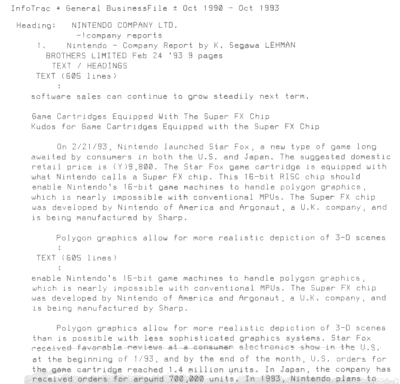
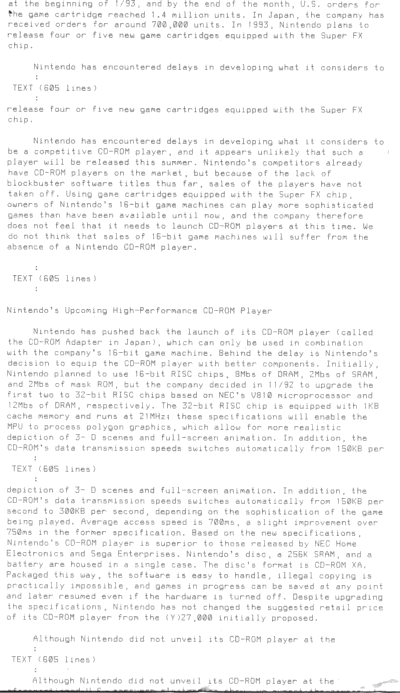
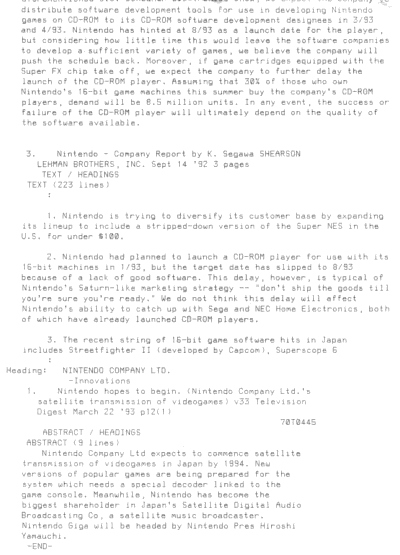
At Last The Contenders: SNES CD/Super
Disc/N Disc Survey
There are at least 2 CD-ROM base units (the
Sony unit and the newer Philips unit). Strictly
speaking, there might be 2 Philips drives. We know average access
time improved from 750ms to 700ms, per the Lehman Brothers
report.
At the end of the
day, the CD-ROM drive is just a CD-ROM drive, with the Philips unit
being superior both in speed (it supports 2x speed) and disc format
(it also supports XA format, if desired). The Philips unit also had
those cute CD caddies with the built-in save RAM, which is smart for
a number of reasons. But again, it's all bulk storage. It's important
to the success of the product, but alone it doesn't elevate any of
the machine's capabilities.
There are at least 3 system cartridges that
hold RAM, and sometimes other processors. Under this model, the
CD-ROM fills the cartridge up with data, and the SNES sees it as a
normal cartridge. It also means you can (theoretically) upgrade the
system by upgrading the system cartridge, much as what NEC/TurboTech
did for the PC-Engine/TurboGrafx-16 Super CD-ROM2 and Arcade
Cartridge upgrades, and much as Nintendo did for the 64DD (which is
just another cartridge underneath the Nintendo64).
Most of the system's magic is in the system
cartridge. This, above all else, makes or breaks the product.
This article is going to demonstrate how pathetic the Sony system
cartridge was, and why it had no future.
Ewww the Sony
So let's start with the embarassment of the
Sony system cartridge:
Sony
Play Station System Cartridge, 1992
|
|
PROOF:
|
We have the teardown
video showing the contents
|
ROM:
|
There is a boot ROM (think of it as a
"BIOS", or in console terms "IPL") and it
holds all the pretty pictures for the splash screen and
initializing the system. There's no magic here. Every system
cartridge will have some flavor of this.
|
RAM:
|
There are 2 SNES "WRAM" custom
DRAM chips, which means 2 megabits (or 256 KBytes) of RAM to hold
data from the CD. (Unclear how this is mapped and whether or not
the SNES can read these at 3.57 MHz or 2.68 MHz like its internal
RAM is.) This is the first huge disappointment. It proves the Sony
unit is more or less just a TurboDuo, scarcely able to
buffer up 1 second of read data from the drive, let alone do much
with it.
|
Backup RAM:
|
All game saves (for your entire CD game
library) must fit on the battery-backed 64 kilobit (8 KBytes) SRAM
inside the system cartridge. This may seem small for RPGs, but
it's identical to how the later Neo-Geo CD works and those
small save states do fit fine. I've never run out of space on my
Neo-Geo CD, but I've also never had to bring it over to a friend's
place to share my game save state. To bring a saved game to
another location, you need to bring the CD disc and your Sony
system cartridge.
|
Coprocessors?
|
NONE! This is the second big
disappointment. Did they really expect the SNES CPU to decode
video and run a game at the same time? You could, but then it'd be
no different from existing cartridge games like Out of This
World. Where's the upgrade? What did you spend all of that
money for if you got nothing new in return?
|
Audio?
|
Red Book CD-DA audio on the side.
|
Philips Drive + Super FX
Now we move on to the first generation
Philips model, promised to be $200 with serious performance upgrades.
This is actually the system cartridge we know the least about
because our sources are more indirect. We have to read a little
between the lines. You also wouldn't believe the incredulity in
Electronic Gaming Monthly editorials (EGM editors always hated
on Nintendo back then), but they were publishing specs as they
received them. Nintendo was always vague about the "coprocessor"
in the system cartridge, but it's painfully obvious that it was
indeed a Super FX. What else did they have at their ready
disposal that ran at that speed, did 3D, already worked with the
system, and had that 3-way bus design? All they had to do is replace
the ROM with a RAM that could be filled by what is also obviously an
ancestor of the "H.A.N.D.S." chip.
It's worth noting we have some conflicts
between these sources:
2 magazine
articles (Electronic Gaming Monthly and Nintendo Power)
hint at 8+1 == 9 megabits of total RAM
One other
Electronic Gaming Monthly article says 4+4+0.25 megabits
total RAM.
The Lehman Brothers article
indicates a total of 10 megabits of RAM, with no mention of how it
was distributed. A logical method would be 4 (HANDS) + 4 (SuperFX
"ROM" bus) + 1 (SuperFX "RAM" bus) + 1 (SNES
exclusive). A similar split-model SuperFX memory map is
well-documented elsewhere, although never really employed in
practice due to cost. (Nintendo’s own SNES development
manual documents a 16 megabit (SuperFX ROM) + 1 megabit (SuperFX
RAM) + 48 megabit (SNES ROM) + 1 megabit (SNES RAM) configuration
that was obviously never used.)
Any of these is feasible. The SuperFX
will happily take up to 1 megabit of its own work RAM, and could
easily take 4, 8, or later on 16 megabits on its ROM bus. It's
evident from the EGM schematic that we probably ended up with
4 megabits of HANDS memory (used for audio, CD buffering work, CD
packet error correction, or whatever else needed), 4 megabits of
memory mapped into the SuperFX's ROM space, and 1 megabit of SRAM
mapped into the SuperFX's RAM space instead of 256 kilobits (FYI
StarFox has 256 kilobits.). That would match the "9
megabit" articles and make the most sense for decompressing
larger 8-bit images. All of this is visible to the SNES as well,
provided everything is set up correctly.
Regardless of the exact RAM configuration,
this system cartridge is quite nice! In fact, it soundly kicks Sega
CD tail. Remember the Sega CD was often called a "downgrade"
for the Genesis because it gave the Genesis only 2 megabits of RAM
plus 4 megabits hidden behind a second 68000 CPU (so, 6 megabits
total, but not all directly visible). Firstly, we instantly benefit
from a 2x CD-ROM drive versus the 1x Sega CD. Also, not only is the
total RAM quantity bigger than the Sega CD, but the SNES can access
all of it with less fuss. We also get a faster coprocessor (SuperFX
over 68000).......at the expense of wide development tool support. I
must concede it's easier to get tools for a popular Motorola chip
than a custom chip. Because the Philips XA format requires ADPCM
audio support, undoubtedly this HANDS chip ancestor also had
the 4 extra ADPCM sound channels the final version had (hence the 4
megabits local RAM), so we also get a clear sound upgrade beyond just
streaming Red Book CD audio.
In fact, the only down side of this
configuration was imminent obsolesence. StarFox itself was on
the horizon. If SuperFX cartridges were already in the wild, what
more could CD-ROM offer beyond bulk storage and extra audio? In fact,
I've always suspected this was why Nintendo was so quiet about this
system cartridge. The marketing department wouldn't want to detract
from either product. StarFox is both a teaser product to whet
your appetite for more, and also a competitor.
Philips
Unit "SuperFX" System Cartridge, 1992 (anticipated
launch: January 1993, pushed back to August 1993)
|
|
EVIDENCE 1:
|
We have the SuperFX patent itself.
#5,357,604, granted finally October 18, 1994. This is evidence,
not proof, as patents are intentionally written as vaguely as
possible to cover broad use cases. Usage in a CD-ROM environment
is specifically detailed in columns 7 and 8.
|
EVIDENCE 2:
|
We have the first Electronic Gaming
Monthly article, from June 1992, issue 35, page 48. This issue is available from Retromags. 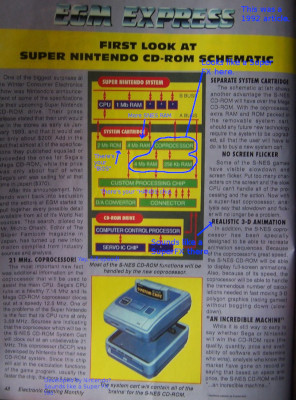
|
EVIDENCE 3:
|
We have the second Electronic Gaming
Monthly article. Electronic Games, April 1993, which discusses the upgrade from "16-bit" to "32-bit". This can be downloaded from Retromags. 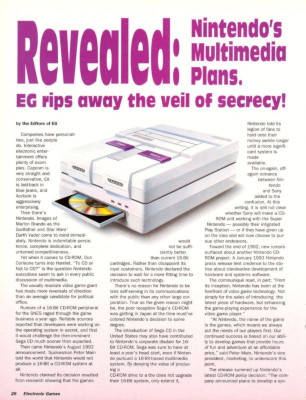 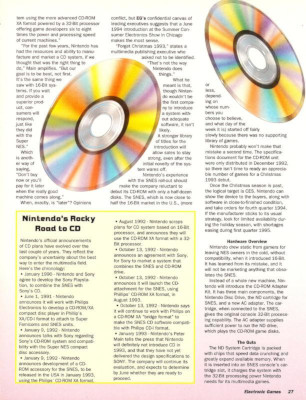 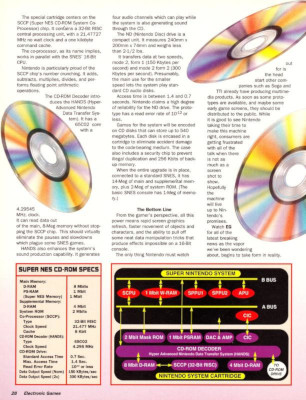
|
EVIDENCE 4:
|
We have the Nintendo Power article,
volume 35, pages 70-71. This makes no mention of processors, and
in one sentence mentions "8 megabits" and in another
mentions "9 megabits". Either this was a misprint or
they are factoring in the SNES’s own 1 megabit internal
WRAM, or they are factoring in an extra megabit for the SNES, or
they are factoring in an extra megabit for the Super FX's working
RAM space.
|
EVIDENCE 5:
|
We have the Nintendo Power article,
volume 43, page 6. The sudden announcement of a 32-bit system
cartridge, claiming that "16-bit" wasn't good enough.
That's reverse evidence that we did, in fact, have a middle of the
road system cartridge like this one.
|
EVIDENCE 6:
|
We have the Feb 24, 1993 Lehman Brothers
financial analyst article by K. Segawa that specifically mentions
the upgrade from "16-bit RISC chips, 8Mbs of DRAM, 2 Mbs of
SRAM". So that implies we had something like 10 megabits in
this era. The distribution is unclear. 4+4+1+1 would be sensible.
(4 for HANDS, 4 for SuperFX, 1 for SuperFX, 1 for SNES)
|
ROM:
|
There is a boot ROM (think of it as a
"BIOS", or in console terms "IPL") and it
holds all the pretty pictures for the splash screen and
initializing the system. There's no magic here. Every system
cartridge will have some flavor of this.
|
RAM:
|
There is a 4 megabit RAM for each processor,
with 4 megabits taking the place of the Super FX ROM, and most
likely 1 megabit of RAM for the Super FX to work with. The types
of these memories (DRAM, SRAM, PSRAM) are unstated. Normally Super
FX RAM is SRAM but it can accept DRAM if needed.
|
Coprocessor 1
|
Super FX According to the articles,
apparently the full-speed 21.477 MHz flavor as well.
|
Coprocessor 2
|
Some early version of HANDS Something
has to manage the CD-ROM drive and its XA filesystem, fill up the
audio RAM, fill up the Super FX “ROM” bus, and play
sounds from audio RAM. Note, however, that in this era HANDS would
not need to convert bitmap graphics to bitplanes yet, as the
SuperFX already has hardware to do that inside.
|
Audio?
|
Judging from the EGM schematic, this looks
conspicuously like the later HANDS chip (described below), so most
likely it had the same 4 on-board ADPCM channels and the 65C02 CPU
to control them, sent through the cartridge analog input ports to
be mixed with the SNES audio.
|
Philips Drive + 32-bit NEC V-810
At last, what we presume to be the final
system cartridge! And what a beauty!
In total we would have doubled the combined
memory of the Sega CD.
We would have a clear improvement in audio
over the Sony drive, as now we have the XA filesystem and 4 extra
ADPCM channels in addition to the CD audio.
The V810 would have far eclipsed the Sega
CD’s Motorola 68000, probably about an order of magnitude on a
good day depending on how we hammer the memory bandwidth. It had
standard assemblers and debuggers, and was also a compiler-friendly
CPU that for the first time would have enabled C language. (No one
used C in consoles then, even on the 68000 which also had C
compilers.)
In fact, the V810 even had an FPU (floating
point math support) which even the later PlayStation CPU did not
have, although realistically this is academic as most games were not
big floating point math users and the V810's FPU wasn't particularly
fast.
The V810, which is a low-cost 32-bit RISC
design, did not have a huge instruction cache, but it was still
double the size of the Super FX instruction cache, and far better
than none on the 68000. We don't know the RAM bandwidth, but it's
most likely larger than the Super FX in aggregate.
Versus the Super FX, we do lose a few
specialty functions. We lose the ability to read from one bus and
write to another in parallel, and we lose the dedicated pixel "PLOT"
function that hid complex address calculations from the programmer.
On the Super FX you can just think in terms of (X,Y) coordinates and
it can figure out what data you mean regardless of 2-bit, 4-bit, or
8-bit pixels, but on the V810 it's all up to you to figure it out.
At this point the programmer is also now
faced with the bewildering task of managing the symphony of 4 very
unique CPUs (the 65C816, the SPC-700, the HANDS chip, and the NEC
V810) and continuous data flow between them. Certainly no less
herculean a task as coordinating two Motorola 68000s, a Z80, and 2
SH-2s with a 32X and Sega CD. But this was indeed the
era (e.g. the twin SH-2 Sega Saturn) where John Carmack
lamented about wishing for just one good CPU.
Philips
Unit 32-bit "NEC V810" System Cartridge, Designed:
November 1992, Announced: early 1993 (intended launch.....sometime
in late 1993 or early 1994)
|
|
PROOF 1:
|
We have the final patent itself, finally
granted in December 1995. It is #5473595. This patent details the bus widths of each memory and the switching operations of HANDS. 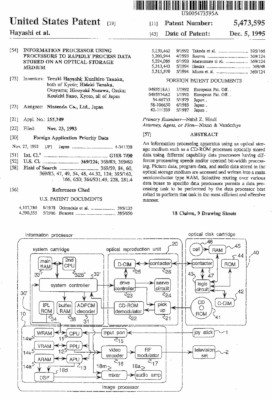
|
PROOF 2:
|
We have a first round of the developers
documentation from Nintendo, 1993.
|
PROOF 3:
|
We have the Lehman Brothers business
article written by K. Segawa.
|
EVIDENCE 4:
|
We have the German magazine article. 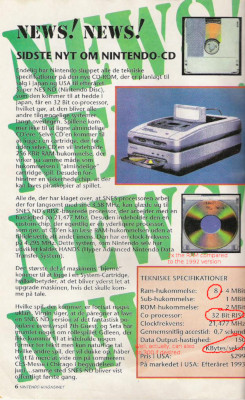
|
EVIDENCE 5:
|
We have the Electronic Gaming Monthly
article, March 1993, volume 44, page 52. 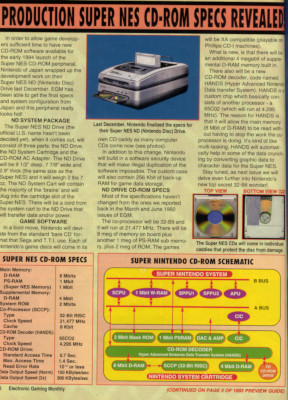
|
EVIDENCE 6:
|
We have the Nintendo Power article,
volume 43, page 6 casually mentioning the upgrade. "Just in
case you haven't heard." Again, the clear intent was to
differentiate the CD-ROM accessory from cartridges at the time.
|
EVIDENCE 7:
|
We have the Nintendo Power article,
volume 44, in the subscribers' only special, writing at length
about both the Super FX and the future 32-bit CD-ROM system as if
they were now separate things (which they are).
|
ROM:
|
There is a 2 megabit (256 KByte) boot ROM
(think of it as a "BIOS", or in console terms "IPL")
and it holds all the pretty pictures for the splash screen and
initializing the system. There's no magic here. Every system
cartridge will have some flavor of this. You *could* hide a few
helper routines if you wanted to find a way to backdoor load them
upstream somehow, but doing so would be of limited value.
|
RAM:
|
HANDS has a 4 megabit PSRAM for its use
(audio, etc.). The V810 has an 8 megabit (1 MByte) DRAM, fillable
and readable by HANDS. And the SNES CPU gets another 1 megabit
(128 KBytes) just to itself.
|
Coprocessor 1
|
NEC V810 This 32-bit RISC CPU was
later used (in slightly different form) in the Virtual Boy
and also the NEC PC-FX. The Virtual Boy
implementation uses a 16-bit external bus to save cost, but is
also customized with a few tweaks, including a lower-latency
multiply operation that matches the cycle count of the Super FX
(16-bit x 16-bit) multiply. That seems like an unusually specific
addition, and one wonders if it was originally meant for this unit
so as not to lose multiplication performance by moving from the
Super FX to this chip. Normally V810 (32-bit x 32-bit) multiplies
are 13 cycles. According to the Super NES CD ROM patent,
apparently this V810 was going to have a 32-bit bus to its memory,
and, like the PC-FX version, this one ran at 21.477 MHz. It
is unclear to me how cleanly the 32-bit bus could be implemented
in such a cramped cartridge housing unless the V810 and HANDS were
housed in the same chip. Either way that was going to be a dense
cartridge.
|
Coprocessor 2
|
HANDS Something has to manage those
bus activities, fill up the NEC V810 RAM (how would this be
arbitrated between them?) and pull compressed audio out of RAM,
contain the on-board 65C02, etc. Also, this final HANDS will need
to convert bitmap graphics (that the NEC chip understands) to
bitplanes (which the Super NES understands) because the V810 has
no dedicated hardware for this and why bog down the CPU with this
task? Similar bitplane conversion hardware also later made an
appearance in the SA-1 coprocessor for the same reason, which
otherwise bears no resemblance to anything here. The 65C02 inside
HANDS runs at 4.295 MHz, and it's not clear by what bank switching
system this 8-bit CPU would access the entire 4 megabit region of
local memory.
|
Audio?
|
HANDS supports 4 on-board ADPCM channels and
the 65C02 CPU to control them, sent through the cartridge analog
input ports to be mixed with the SNES audio. The ADPCM data can
come from either the local 4 megabit memory and/or streamed off
the disc. And here's where the Philips XA format becomes useful,
too. If you have both streamed data (video or otherwise) and audio
that need synchronization, they can be stored together as part of
the XA format and the audio can be processed in parallel with the
data.
|
So now let's put
all of this in context with the competitive landscape:
CD-ROM
ADD-ONS FOR
|
NEC
TurboGrafx-16/PC-Engine
|
Nintendo
Super NES (Sony CD-ROM) (1991-1992 vintage)
|
Nintendo
Super NES (Philips CD-ROM + SuperFX) (1992-1993 vintage)
|
Sega
Genesis/MegaDrive
|
Nintendo
Super NES (Philips CD-ROM + 32-bit V810) (1993 vintage)
|
SNK
Neo-Geo
|
Vintage
|
1988-1994
(various)
|
1991-1992
|
1992-1993
|
1991-1992
|
1993
|
1994
|
Additional
RAM (not including backup)
|
512
kbit (64 KByte) for CD-ROM2 (1988/1990)
or
2 megabit
(256 KByte) for Super CD-ROM2 (1991/1992)
or
18 megabit
(2.25 MByte) for Arcade Card (1994)
|
2
megabits (256 KBytes)
|
8
megabits (1 MByte) + either 256 kbit or 1 megabit SuperFX RAM
|
6
megabits (0.75 MByte) + 512 kbits (64 KB) in total; 2 for Genesis,
4 for coprocessor only, rest for ADPCM sound decoder
|
13
megabits (1.625 MByte) in total; 1 for SNES, 4 for HANDS, 8 for
V810
|
56
megabits (7 MBytes) in total across all cartridge buses
|
Coprocessors?
|
None
|
None
|
Yes.
2: HANDS + SuperFX
|
Yes.
Supplemental Motorola 68000 and sound decoder
|
Yes.
2: HANDS + V810
|
None
|
CD-ROM
speed
|
1x
|
1x
|
2x or
1x
|
1x
|
2x or
1x
|
1x
until Japan-only CD-Z
|
Audio?
|
Disc
Streaming + 1 ADPCM channel
|
Disc
Streaming
|
Disc
Streaming + supplemental 4-channel HANDS ADPCM decoder
|
Disc
Streaming + Supplemental 8-channel RF5C164 ADPCM decoder
|
Disc
Streaming + supplemental 4-channel HANDS ADPCM decoder
|
Disc
Streaming
|
Backup
memory?
|
Built
in to TurboDuo (not transportable)
|
Built
in to cartridge (awkward but portable)
|
Built
into disc caddy (portable)
|
Built
in and optional memory cartridge.
|
Built
into disc caddy (portable)
|
Built
into console (not transportable)
|
In this era, any Nintendo CD-ROM accessory
has 2 chief competitors to fend off: 1. the outside competition and
2. the ever-growing cartridge itself.
The original
Sony CD-ROM accessory stood no chance of lasting in the market. It's
just a TurboDuo! By 1993 we had 16 megabit cartridges with eyes
toward 24 and 32 by the end of 1994. Did we really need to limit
game developers to loading no more than 2 megabits at a time off a
disc?
The original
Sony CD-ROM accessory featured no coprocessors of any kind at a time
when Nintendo was already working with Argonaut on what
became the SuperFX. That meant that cartridges were growing
in both size and capability while the CD-ROM just had (slow)
bulk storage behind it.
The Philips
CD-ROM + Super FX combination was pretty solid! This would fare well
against the Sega CD.
The
Motorola 68000 is far easier to develop for, with more tools behind
it. However, the SuperFX is considerably faster when treated right.
It would be a great tool for the same uses as that 68000 ---
software graphics decompression, sprite scaling, sprite rotation,
etc.
Nintendo's
unit would have far more RAM available for sound than Sega CD.
Great for beefy, bulkier sound effects.
Nintendo's
unit would share 4 megabits of RAM directly (and transparently)
between the Super NES itself and the SuperFX, so you could use it
however you needed to.
Nintendo's
drive was faster when called to be so (i.e. not when streaming
audio).
The Philips
CD-ROM + V810 combination was really solid! This would surpass the
Sega CD. At last we might have a unit with a few years of
life in it.
The V810 is
faster than the 68000, compiler-friendly, and had official
toolchains at the time.
The even larger RAM could buffer up
more data. The V810 could be used as a graphics decompressor or
even run game logic if desired. These are things that weren't quite
cheap enough to build onto a cartridge (yet).
Was There a Fourth CD-ROM?
Short answer: NO!
If you read
Diehard Gamefan, August 1994, Volume 2, Issue 9, page 157, you
came across this perplexing rumor.
As tantalizing as the idea
may be (having a beefy CPU to run a game engine and a “Super FX
3” to draw the graphics), at that point you might as well just
make a new system from scratch or else you just have another Sega
32X.
Imagine the chaos of programming the SNES (2 CPUs) and an
R3000A and a “Super FX 3” and coordinating it all. And
fitting it physically into a cartridge. What a mess. And in the end
you’re still limited by the VRAM and DMA performance of the
SNES anyway.
Indeed, I think this author just got some wires
crossed and is confusing the Super NES CD-ROM effort with the
aforementioned Argonaut stereoscopic display system. That fits all
of the other details of the story: “new market”,
“projection system”, “VR effect”, “VR
headset”.
Ultimately, this Argonaut VR project was
scrapped for the Virtual Boy instead. My suspicion is political
expediency. When the CD-ROM project was cancelled, NEC lost
potential sales on its V-810. And yet this was the same NEC
that was contracted to build chips for N64. Better to keep NEC
happy and sacrifice Argonaut instead? Not to mention a
project to keep your in-house engineers occupied while their other
foreign-designed (Silicon Graphics, Inc.) console made
progress.
The final patent for Nintendo’s
CD-ROM never makes any mention of such things either.

Let's Compare the CD-ROMs Against the
Tournament Fighters
For this example let’s use Rare’s
1995 Super NES port of Killer
Instinct. It was a 32-megabit
cartridge with no special hardware at all. We all knew it was cut
down from the arcade original, and yet it was very well-received in
spite of this. It made a great tide-me-over while we waited for the
Nintendo 64 and it played well despite its obvious limitations.
The
game features 11 combatants.
We can’t dive too deeply into
the guts of this game here. For certain there is plenty of generic
stuff inside: the main program, the sound driver to play back music
scores, common title screen and character select screen graphics, and
of course all of the narrator combo announcements like “Super
Combo!” or “Monster Combo!”. I don’t know
how much that all takes.
So let’s for now assume 30
megabits divided by 11 or just under 3 megabits per character.
This
is all armchair back-of-the-napkin arithmetic.
And that 3
megabits includes: one or two background levels, music score,
character sound effects, character data and graphics (undoubtedly
compressed somehow), and each character’s victory pose and
game-ending story scenes.
Sony CD-ROM
If we ported Killer Instinct onto the Sony
CD-ROM, the only tangible gains would be:
1) We can stream the
original arcade audio off the CD-ROM. This is good for quality (but
adds lag seeking tracks). That saves the SNES audio memory to hold
the sound effects.
2) We can leave the victory and game endings
on the disc (maybe even as short videos or simple animations!) as
they can be loaded as-needed. The result is they can be bigger and
take more space. Again, disc seeking lag is still a factor.
We can load the background graphics and
sound effects to the SNES’s own audio RAM and video RAM
directly. Maybe we can load the main program to the SNES’s
internal WRAM and have some room to spare if we are lucky. But since
that system cartridge just has 2 megabits of RAM, we have maybe only
1 megabit per combatant left to fit all their moves (graphics and
data).
It is hard to see this as a real win over the
cartridge! The in-game play is probably already compromised.
It’s
not even clear that all of the combo announcements would fit anywhere
in any of the RAMs to load into the SNES audio memory when needed.
(I don’t know how much space those take.)
The overall footprint of the game would be
much bigger than the SNES cartridge (because the audio tracks and
maybe the game endings could take up lots of space) but the in-game
action feels worse -- like maybe 1 or 2 megabits per
character times 11 characters, or about 22 megabits in total.
It
feels more like a DOWNGRADE.
So would this $200 machine really be an
“upgrade” to an SNES in 1992 or 1993? Only to be outdone
by a cartridge in 1995?
That’s fundamentally why this was
such a dead-end design.
Philips CD-ROM + Super FX
The Philips CD-ROM + Super FX system cart
combination already helps us.
Again, we gain:
1) We can
stream the original arcade audio off the CD-ROM. This is good for
quality (but adds lag seeking tracks). That saves the SNES audio
memory to hold the sound effects.
2) We can leave the victory
and game endings on the disc (maybe even as short videos or simple
animations!) as they can be loaded as-needed. The result is they can
be bigger and take more space. Again, disc seeking lag is still a
factor.
3) And now we also have roughly 4 megabits of
audio memory, assuming a little overhead for other activities that
HANDS might perform. (HANDS has supplemental ADPCM decoder channels,
which are required by the XA format, so you might as well use them
while streaming the background audio off the disc, right?) With any
luck, hopefully this can hold the combo announcements and leave room
for better quality character sound effects. And you can still play
hits and smacks on the SNES audio itself.
4) And now we have
roughly 4 megabits of storage on the Super FX (minus a little program
code overhead). We can also use the Super FX to do whatever graphics
decompression duties might be useful.
So now we can bat somewhere in the range of
3-4 megabits per combatant for the in-game action, or about 33-44
megabits total. Again, not counting the audio or game endings or
victory animations. The in-game action should be about equal to the
cartridge, and maybe a little faster with the FX doing decompression
for us.
Just about everything (audio, character graphics, combo
announcements) ought to be as good or better.
And that’s
why this unit starts to shine.
Furthermore, data
loading off the disc COULD be double-speed, although audio streaming
still has to be 1x. And skipping around to load up characters can
still be laggy.
Still, I hope it’s clear that this unit
just beat the pants off the Sony drive.
Philips CD-ROM + NEC V-810
Virtually the same scenario as
above.
Admittedly now we’ve traded out the Super FX for
the NEC V-810. We lose dedicated pixel plotting hardware for a more
general-purpose CPU, but it’s beefy enough. It could probably
run the whole game itself if we wanted to, meaning faster action
everywhere.
But now we’ve also got even more local RAM
hooked up to it. A portion of it is required to hold its program
code and work space. So, just guessing if we have 7 megabits left
over….
That becomes about 3.5 megabits of graphics + 1-2
megabits audio per combatant or about 4.5-5.5 megabits each.
Or
the equivalent of a 49-60 megabit cartridge plus room for audio and
ending animations.
So here, if you are willing to put up
with CD-ROM lag, you can get a genuine upgrade over the cartridge.
It would never match the arcade original, but it’d be nice!
...But For How Long?
We should have seen 64-megabit Super NES
cartridges. There are a number of ways to map that much space on the
console. Even the SA-1 can do it.
However, we never got
any Super NES games that big because:
1) 64-megabit ROMs were late to market.
Moore’s Law is not perfect and there are occasional hiccups.
This hiccup hurt us.
2) The capacity was being hoarded for the
first round of Nintendo64 cartridges, which ended up not arriving to
market before late 1996 anyway.
3) Developers were already
moving to the new consoles.
But if we DID have a
64-megabit cartridge back then it would have given fresh competition
to the above examples. Especially if bolted to the various special
chips Nintendo had at the time.
With Rare porting Killer
Instinct 2 for the Super NES (which was in development and
cancelled), one could have dreamed for such a configuration. The
cartridge they used was never confirmed.

Back
 Even
though this site is supposed to be a 1990s style tribute to StarFox,
we need to get some SNES CD-ROM history sorted out. It’s too
easy to get confused with the stupid Sony debacle, the Philips
drive, the SuperFX, and the “32-bit”ness.
Even
though this site is supposed to be a 1990s style tribute to StarFox,
we need to get some SNES CD-ROM history sorted out. It’s too
easy to get confused with the stupid Sony debacle, the Philips
drive, the SuperFX, and the “32-bit”ness.










